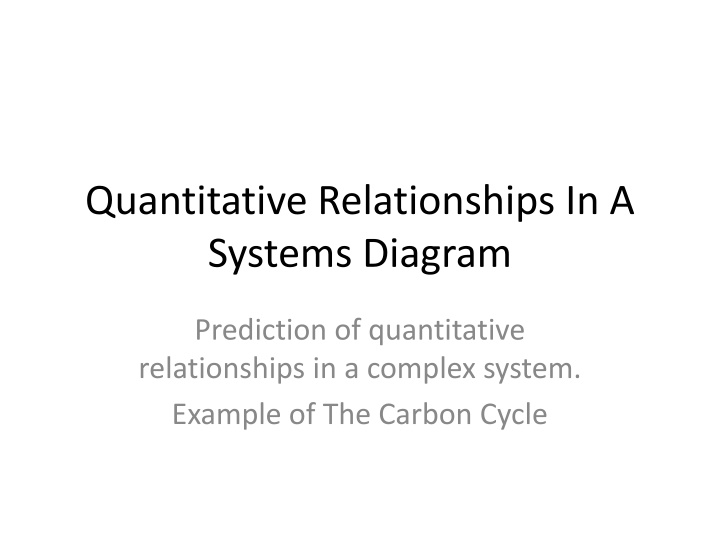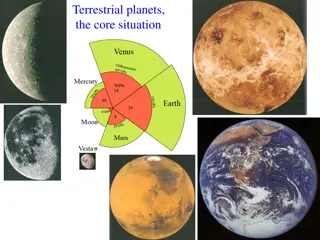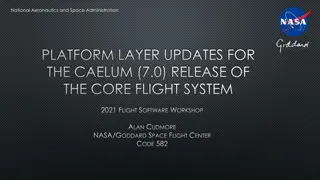Introduction to Core Flight System Workshop
Core Flight System (cFS) is a NASA multi-center open-source flight software framework with a layered architecture and international standards-based interfaces. It offers development tools, a runtime environment, and reusable NASA artifacts for user applications. The cFS framework is ported to platforms and augmented with applications to create distributions for worldwide use by a diverse community from government, industry, and academia. Explore the historical context of cFS's development and the birth of a collaborative community dedicated to advancing flight software technology.
Uploaded on Mar 02, 2025 | 1 Views
Download Presentation

Please find below an Image/Link to download the presentation.
The content on the website is provided AS IS for your information and personal use only. It may not be sold, licensed, or shared on other websites without obtaining consent from the author.If you encounter any issues during the download, it is possible that the publisher has removed the file from their server.
You are allowed to download the files provided on this website for personal or commercial use, subject to the condition that they are used lawfully. All files are the property of their respective owners.
The content on the website is provided AS IS for your information and personal use only. It may not be sold, licensed, or shared on other websites without obtaining consent from the author.
E N D
Presentation Transcript
Quantitative Relationships In A Systems Diagram Prediction of quantitative relationships in a complex system. Example of The Carbon Cycle
The Carbon Cycle With Measurable Quantities Identified ppm Value Can Be Measured % reflectivity g/m3 mm/hr mm/hr Units of Measured Quantity ppm g/m2 lbs CO2/kWh houses/mi2 % coverage W vehicles/hr % cultivated land L/hr g C/kg soil #/L Others? mg/L #/L mm/year
Using Quantitative Relationships In A Systems Diagram to Transform It Into a Model of a System Example of The Carbon Cycle
Converting a Diagram into a Model A diagram illustrates connections and relationships. A model allows for a quantitative understanding and quantitative predictions by: Including values for fluxes and rates Including quantities for reservoirs Diagram of a Bathtub System Model of a Bathtub System faucet Water in bathtub drain
The Carbon Cycle Fluxes and Reservoirs Indicated Figure 6.1 | Simplified schematic of the global carbon cycle. Numbers represent reservoir mass, also called carbon stocks in PgC (1 PgC = 1015 gC) and annual carbon exchange fluxes (in PgC yr 1). Black numbers and arrows indicate reservoir mass and exchange fluxes estimated for the time prior to the Industrial Era, about 1750 (see Section 6.1.1.1 for references). Fossil fuel reserves are from GEA (2006) and are consistent with numbers used by IPCC WGIII for future scenarios. The sediment storage is a sum of 150 PgC of the organic carbon in the mixed layer (Emerson and Hedges, 1988) and 1600 PgC of the deep-sea CaCO3 sediments available to neutralize fossil fuel CO2 (Archer et al., 1998). Red arrows and numbers indicate annual anthropogenic fluxes averaged over the 2000 2009 time period. These fluxes are a perturbation of the carbon cycle during Industrial Era post 1750 . Ciais, P., C. et al., 2013: Carbon and Other Biogeochemical Cycles. In: Climate Change 2013: The Physical Science Basis. Contribution of Working Group I to the Fifth Assessment Report of the Intergovernmental Panel on Climate Change [Stocker, T.F., D. Qin, G.-K. Plattner, M. Tignor, S.K. Allen, J. Boschung, A. Nauels, Y. Xia, V. Bex and P.M. Midgley (eds.)]. Cambridge University Press, Cambridge, United Kingdom and New York, NY, USA. p. 471,
The Carbon Cycle Fluxes and Reservoirs Quantified Figure 6.1 | Simplified schematic of the global carbon cycle. Numbers represent reservoir mass, also called carbon stocks in PgC (1 PgC = 1015 gC) and annual carbon exchange fluxes (in PgC yr 1). Black numbers and arrows indicate reservoir mass and exchange fluxes estimated for the time prior to the Industrial Era, about 1750 (see Section 6.1.1.1 for references). Fossil fuel reserves are from GEA (2006) and are consistent with numbers used by IPCC WGIII for future scenarios. The sediment storage is a sum of 150 PgC of the organic carbon in the mixed layer (Emerson and Hedges, 1988) and 1600 PgC of the deep-sea CaCO3 sediments available to neutralize fossil fuel CO2 (Archer et al., 1998). Red arrows and numbers indicate annual anthropogenic fluxes averaged over the 2000 2009 time period. These fluxes are a perturbation of the carbon cycle during Industrial Era post 1750 . . . Ciais, P., C. et al., 2013: Carbon and Other Biogeochemical Cycles. In: Climate Change 2013: The Physical Science Basis. Contribution of Working Group I to the Fifth Assessment Report of the Intergovernmental Panel on Climate Change [Stocker, T.F., D. Qin, G.-K. Plattner, M. Tignor, S.K. Allen, J. Boschung, A. Nauels, Y. Xia, V. Bex and P.M. Midgley (eds.)]. Cambridge University Press, Cambridge, United Kingdom and New York, NY, USA. p. 471,
The Carbon Cycle Atmospheric CO2 Concentration Changes with Time ppm
The Carbon Cycle % Land In Agricultural Production Changes with Time % World Arable Land in Agriculture (http://faostat3.fao.org/download/E/EL/E) 39.0 % coverage 38.5 38.0 37.5 37.0 36.5 % 36.0 35.5 35.0 34.5 34.0 33.5 1950 1960 1970 1980 1990 2000 2010 2020 Year
Discussion Questions What understanding of The Carbon Cycle do you gain from using the systems diagram that you would not get by looking only at individual relationships within the system? Which discipline or disciplines are contribute the most to your current understanding of The Carbon Cycle, and which one(s) will be most instrumental in helping to increase your understanding of it? How has your understanding of The Carbon Cycle grown or changed by labeling components and/or by including quantitative measures of reservoirs, fluxes, and/or values that change with time? Would the use of a system diagram such as The Carbon Cycle Diagram help you address questions about the impact of a change in policy, and thus human activity, on The Carbon Cycle? For example, what would happen if coal-fired power plants were suddenly banned, or if regulations on fisheries were suddenly lifted?























